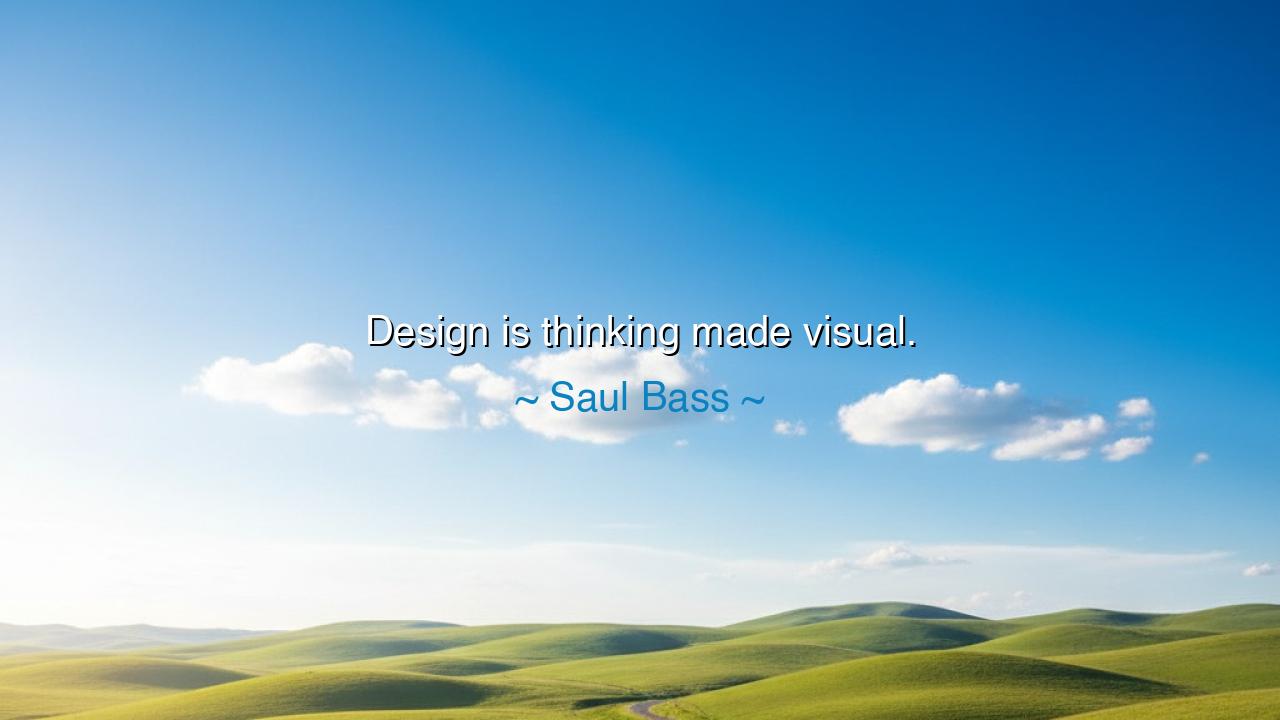
Design is thinking made visual.






When Saul Bass, the master of motion and simplicity, declared, “Design is thinking made visual,” he was not merely speaking of posters, logos, or film titles — he was speaking of the alchemy of creation itself. In those five words, he captured the sacred bridge between the mind and the eye, between the invisible idea and its visible form. For what is design, if not the act of translating the silent whispers of imagination into shapes, colors, and movement that others can feel? It is thought incarnate, a language without words, a mirror in which the intellect of the creator takes on flesh.
In the beginning of all art, there is thought — a spark, a question, a vision not yet born. The designer is like an ancient craftsman of light, shaping this invisible essence into something tangible, something that can speak to the soul without uttering a syllable. Bass himself, in his iconic film title sequences — from Vertigo to Psycho — proved that design could think, could feel, could tell stories before the story began. His work whispered that form is never separate from meaning, that beauty without purpose is an empty shell. Through design, thought finds a body, and through that body, it walks among men.
In the temples of old, even before the written word, humankind already practiced this truth. The builders of the pyramids, the carvers of stone, the painters of caves — they all made thinking visual. A symbol drawn on rock was more than decoration; it was thought preserved in image, a message from one soul to another across time. The hieroglyph, the fresco, the mosaic — all were born from the same impulse that drives modern design: the desire to make meaning visible. Thus, Bass’s wisdom is ancient in its core. He did not invent it — he revealed it anew for the modern age.
Consider also the tale of Leonardo da Vinci, that eternal union of mind and hand. When he drew the Vitruvian Man, he was not merely illustrating anatomy. He was revealing a philosophy — the harmony between the human form and the universe. The circle and square became symbols of proportion, of divine logic rendered visible. In that drawing, thinking became design, and design became revelation. It is a lesson that the greatest ideas do not live in words alone; they demand a form, a rhythm, a balance that the eyes can see and the heart can feel.
But Bass’s words also carry a challenge — that to design well, one must first think well. The beauty of a line, the power of a layout, the silence of white space — all must serve intent. A careless hand may decorate, but a mindful hand communicates. Design is not the art of making things pretty; it is the art of making thought visible and true. When thinking is shallow, the design becomes hollow. But when thought is deep — full of empathy, clarity, and insight — the design becomes timeless, capable of stirring emotion even in distant hearts.
In our age, flooded with images and noise, this teaching grows ever more urgent. Many create without reflection, filling the world with symbols that do not speak. Yet the designer’s calling, as Bass knew, is sacred: to take the raw material of thought and shape it into something that guides, inspires, or awakens. Whether one designs a logo, a building, or a life, the principle remains — the outer form must serve the inner truth. Every mark, every motion, must be an echo of purpose.
So, O seeker of craft and meaning, remember this: let your designs think, and let your thoughts design. Do not chase beauty without understanding, nor intellect without emotion. Before you draw, ask why; before you color, know what you wish to reveal. Make every creation a vessel of wisdom, every image a spark of insight. For the world does not need more decoration — it needs more clarity, more truth made visible.
Thus, follow the ancient wisdom that Saul Bass rekindled for our time: when your thinking is pure, your design will shine; when your purpose is noble, your creation will endure. For to design is to give thought a body — and to do so with care and intention is to leave a trace of your mind upon eternity.






AAdministratorAdministrator
Welcome, honored guests. Please leave a comment, we will respond soon